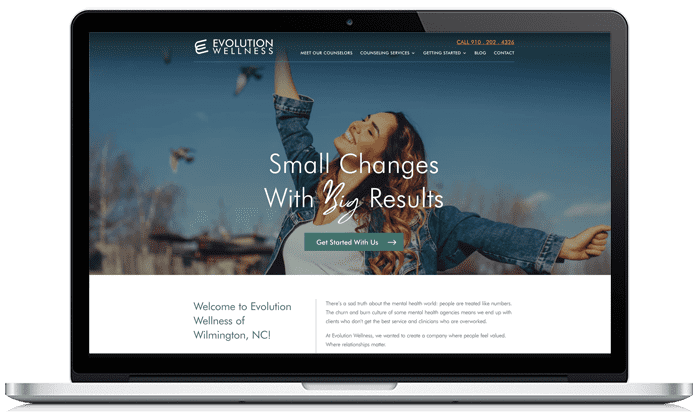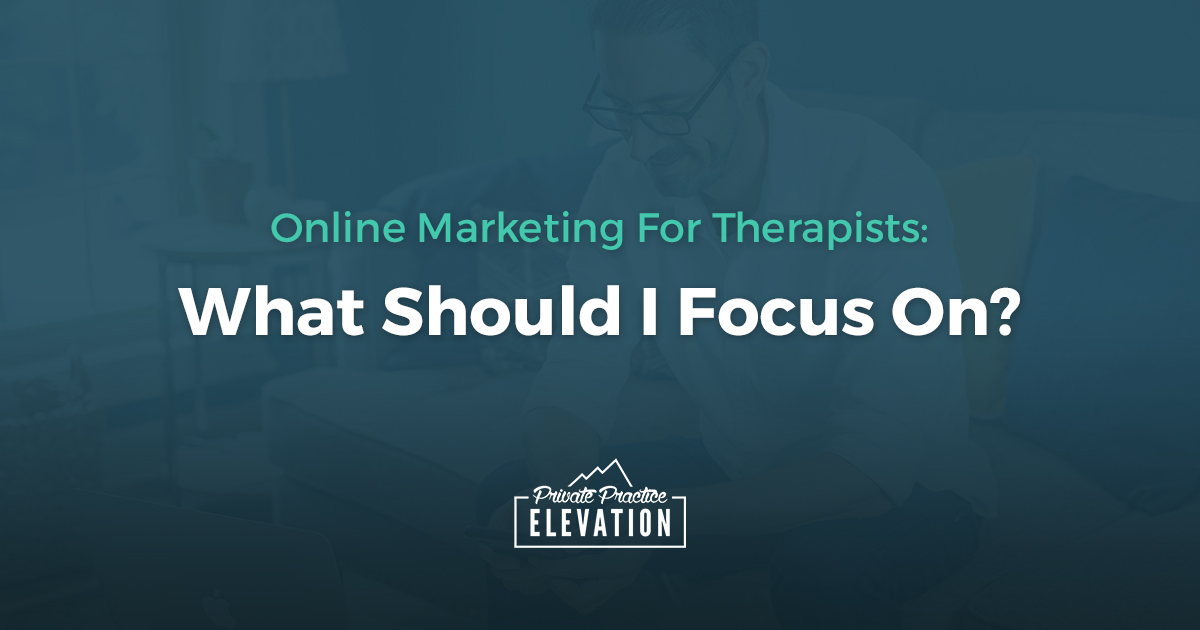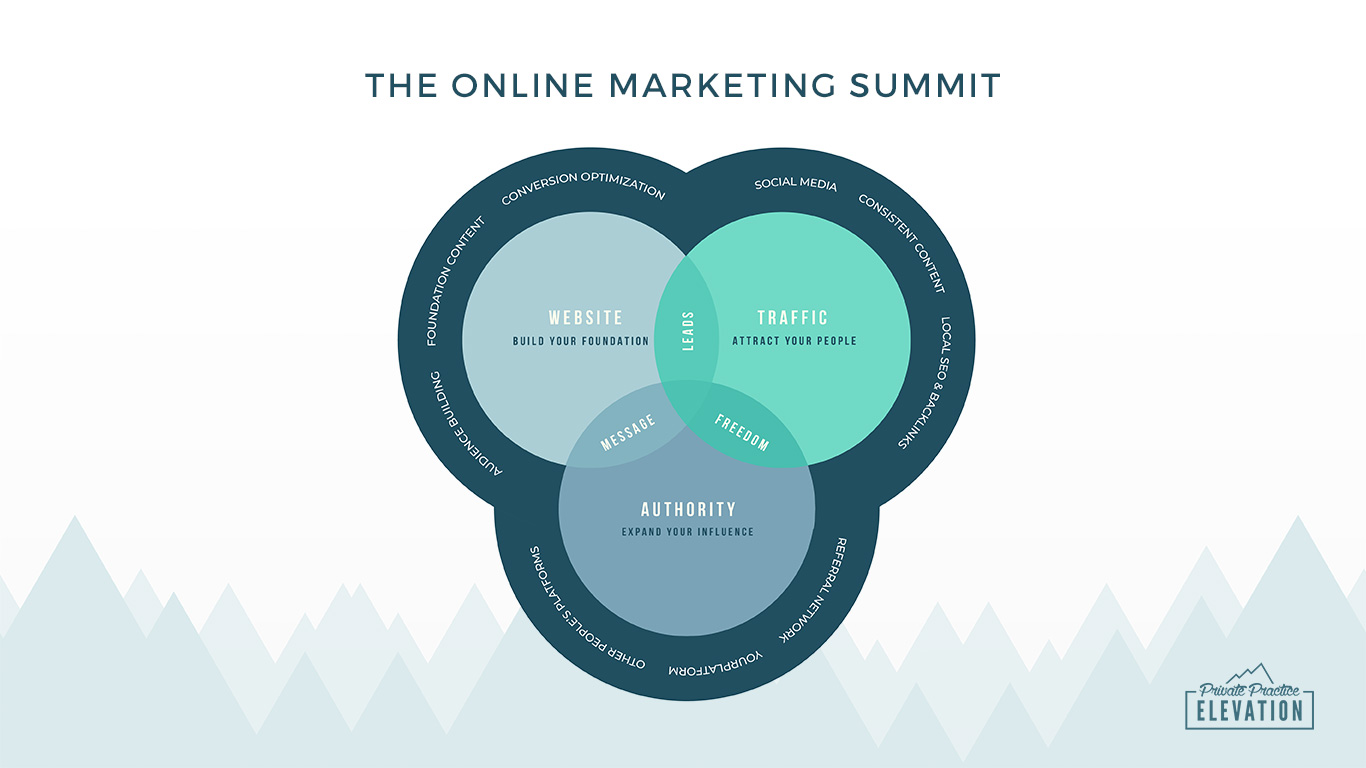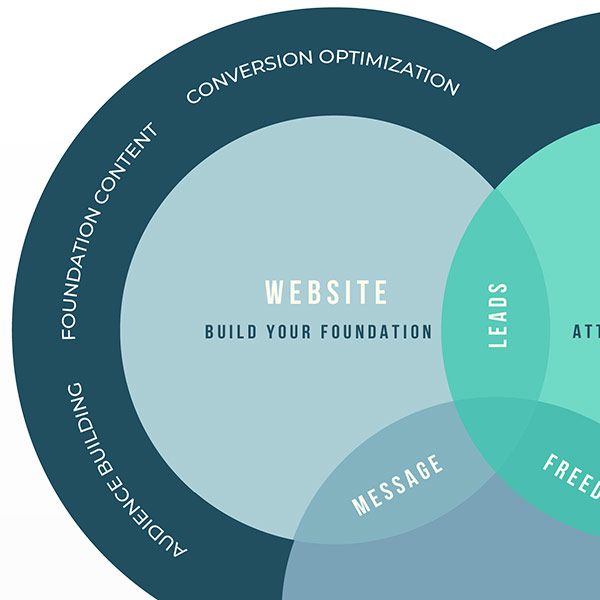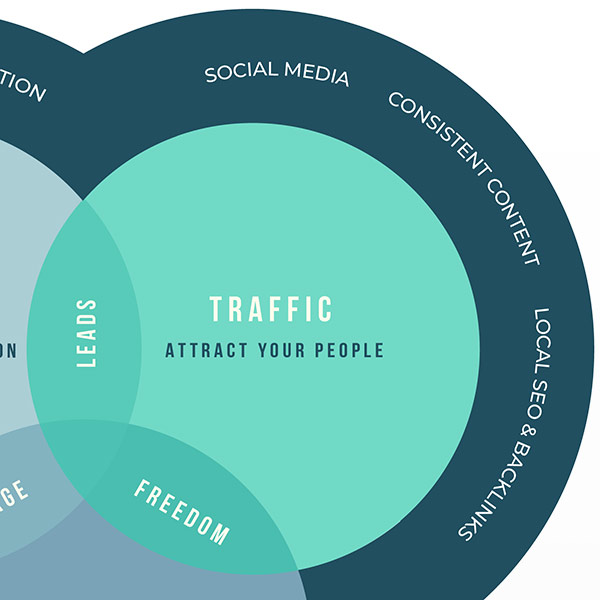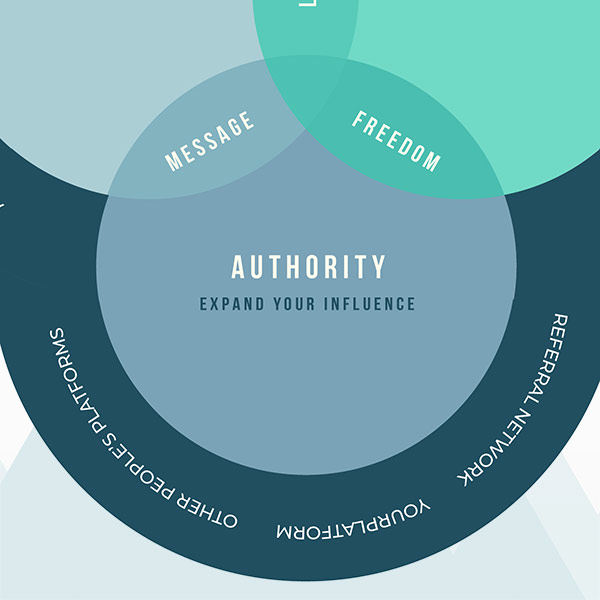Online Marketing For Therapists: What Should I Focus On?
Our complete philosophy and game plan for getting more clients and reaching more people with your online marketing.Since I began serving private practice owners and teaching online marketing for therapists in 2016, there’s one question I get asked more than any other.
It’s a question I think pretty much every business owner has asked at one point or another in their journey toward profit and successful private practice leadership.
Here is the question:
“What should I focus on now in order to market my practice well online?”
Or, to put it another way, “there’s so much I feel like I should be doing. What’s the right thing?”
What’s interesting about this question is that the answer can be different from one practice owner to the next.
But knowing the answer to this question is of extreme importance.
If you don’t know what marketing tasks or projects are going to be the most impactful to the growth of your business – in your current stage of business – you’ll end up taking on too many things, spreading your marketing efforts thin and not getting enough traction to gauge what’s working and what isn’t.
On the flip side, if you know where you’re at currently and understand where you want your practice to go, you can more easily determine those marketing opportunities that will help get you closer to your goal.
I know I’ve been guilty of shiny-object-syndrome when trying to build my own business.
Anyone with me?
You say things like, “If I just had an email list really dialed in, then I’d have more clients!”
Or “If my about page copy was better at speaking to my ideal clients, then I’d have more of them!”
Both of those statements may actually be true, but when the underlying emotion is fear, you’re simply unable to solve your problem (or perceived problem); your lack of clients.
A Simple Online Marketing Framework for Your Private Practice
So how do you determine where you’re at and what to focus on when it comes to all the marketing activities you could spend your time or money on?
I want to introduce you to a framework that we’ve been using at Private Practice Elevation to help coach our clients with their marketing and where to invest their time and money.
It’s something I’ve named the Online Marketing Summit (as in summit of a mountain) and it’s going to help you get a high-level view of the marketing for your private practice and how all the pieces work together to lead you to your marketing goals.
I call it the Online Marketing Summit because, as you grow your business, you can add more elements to your marketing to help you reach the next level.
The next elevation of your private practice.
Each part of your marketing works together and when they are all in place, in the right order, acceleration of growth can occur.
This framework is made up of three main aspects of your digital marketing:
- Your Website
- Your Traffic
- Your Authority
And they happen in that order within your private practice and it can be as simple as that.
Build the foundation of your marketing around a professional website.
Then attract your ideal clients by getting traffic to your website.
Then expand your influence and accelerate your traffic and leads by increasing your authority in your niche or community you feel called to serve.
Now, within each of those buckets may be a host of other tasks, projects or pieces to your marketing puzzle, and we’ll talk about that more, but this gives us a high-level view to begin to understand where we’re at with our business and what we can begin to focus on.
You can check out the diagram below to better understand The Online Marketing Summit and how these three pieces work together:
1. Your Private Practice Website: Build Your Online Marketing Foundation
Your therapy website is ground zero for attracting your ideal clients to your private practice.
In this modern world, you’re simply limiting your growth if you don’t have a website that you can send people to learn more about you and your services.
I was going to say that you’re cutting off one of your feet while still trying to hike to the summit, but that sounded dramatic.
If you’re just starting out and your marketing budget is low, DIY a therapy website so you can at least get some traffic and have a place to send people.
You’ll likely have multiple websites for your practice as you continue to grow, learn about your ideal clients, invest, then grow some more.
You may end up with a page or blog post on your website that ranks well in Google and brings in new clients, but you’ll never know if you don’t start somewhere.
For those who may be more established in your private practice, you’ll likely have more data and more of a budget to begin optimizing in the website stage of your marketing.
If you have a website that looks professional, works well on mobile phones and generally represents your practice well, then you can begin to focus on the supporting tasks of this stage to help you level up.
Or if your website isn’t cutting it, you can focus more on the following aspects during a website redesign.
At the Website stage, we focus on:
1. Foundation Content
2. Conversion Optimization
3. Audience Building
Let’s break these down a bit, shall we?
1: Foundation Website Content
I call this foundation content because, if done well, the content on your website can serve as the foundation, the base camp, the launch pad for all your online marketing.
Do it right and you’ll not only attract steady traffic to your website month after month from Google, but that traffic will be the right traffic.
It will be filled with the types of clients you want to work with who are eagerly looking for your services.
So in this bucket, we’re talking about SEO, yes, but we’re also talking about copywriting and knowing how to speak in a way that resonates with your ideal clients.
The most important piece of this strategy will be your homepage, your service pages, and your about page. In that order.
Many private practice owners I consult with are wondering why they’re getting little to no traffic from Google.
Sometimes they’ve spent hours and hours writing lots of content for their website.
But if that content is not optimized for the keywords your ideal clients are using, then it’s going to be very hard to get found. At least when you’re starting out before you have the other pieces of the Online Marketing Summit working for you.
The best thing you can do at this stage is to work with a copywriter who understands SEO and make sure they write detailed content for each and every service you offer.
You can start at the top with things like Couples Counseling and Individual Counseling. But if you really want this to work, take it a step further with the different topics you help your clients with within each of those categories.
Pages like “Anxiety Therapy in Atlanta”, “Divorce Counseling in Atlanta”, “Counseling for Single Entrepreneurs in Atlanta”.
You see how specific you can get there?
Now, once all this foundation content is in place, you’ll be able to spend less time and effort trying to get traffic from Google and more time amplifying your traffic through other means, which we’ll discuss later.
2: Website Conversion Optimization
What’s the point in having it if it’s not helping you reach your goals?
That’s why it’s extremely important to think about conversion optimization for your private practice website.
This is where it’s beneficial to work with a professional.
If it’s in the budget, do it!
A professional website designer or agency will understand the aspects of user experience and how design plays into increasing conversions from the website.
Because they’ve built many websites and hopefully work closely with their clients, they’ll understand what works with design and what hinders it.
At this stage you’ll want to maximize the traffic that’s coming to your website by making sure the path between landing on a page and reaching out to begin therapy is one that’s clear and easy to walk down.
You don’t want to invest in advertising or SEO services and send traffic to a crappy website that people can’t use or figure out how to find the information that’s important to them becoming your next client.
3: Audience Building
As Russell Brunson, creator of ClickFunnels, mentions in his book, Traffic Secrets (affiliate link), there are three types of website traffic:
- Traffic you earn (by building relationships, being on podcasts, guest blogging, etc)
- Traffic you buy (Google ads, Facebook ads, etc)
- Traffic you own
When you use your website and online presence to collect a list of email addresses, you’re developing a marketing asset that no one can take away from you.
To a lesser extent, your social following can be included in the “traffic you own” category, but Facebook, Youtube, Instagram, etc could shut down your account at any time. Hopefully not, but it does happen.
Having an email list or social followers means that you have at your disposal an audience of people who have expressed interest in your message, or services or expertise, that you can reach out to whenever you want to.
If you have a stellar website for your private practice, optimized to get you traffic from Google the next step is to convert that traffic into either a client or a subscriber.
We all want more clients, right?
But not everyone will be ready to do business with you the first time they land on your website.
You can offer those folks a detailed guide that will help them with their challenges right now, as a way to serve them and educate them on your expertise.
You can continue to reach out to them to remind them why they came to you in the first place, and hopefully convert them into a paying client.
Your Website: Conclusion
It’s true that you can manage to get lots of traffic to your website by hustling with your networking and putting out tons of content.
But if that website is not optimized for your ideal clients, or the design is hindering conversions into clients and subscribers, you’re missing out on a potential catalyst for your business growth.
Nail your private practice website down, start gathering data on your traffic and keywords, and then you can begin to accelerate things by moving to the next stage: Traffic.
2. Your Traffic: Attract Your People
Ok, so you’ve got a great website that you’ve invested in.
It’s got a host of pages that are foundational to your services and what your private practice offers.
That content resonates with your ideal clients so it’s already begun to attract some traffic.
You’ve spent considerable time making sure that website is easy to navigate and easy for potential clients to reach out to get started working with you, or join an email list for those who aren’t quite ready.
So the website is converting visitors into warm leads and clients.
Now comes the fun part, where we layer on the strategy and start getting more eyeballs on this beautiful piece of marketing collateral we call your private practice website.
And you may have heard me say this before, as it’s one of my mantras:
If you think that now that your website is live and it has some great content that hordes of traffic will flock your way, you’re living in a field of dreams, my friend 😉

Putting some work in at the traffic stage of your marketing journey now can mean automating that traffic in the future as you shift your focus to even bigger things for your private practice.
So let’s talk about the areas of focus available to you at this stage.
At the Traffic stage, we focus on:
1. Consistent Content
2. Directories, Backlinks & Local SEO
3. Social Media
4. Paid advertising

1: Consistent Content
I’m starting with this one first in the traffic stage of your digital marketing because we’ve seen the best results from this strategy.
So, what do I mean when I say “consistent content”?
This means that you have a plan to publish new content, related to your services and the questions your ideal clients may be asking.
This could take the form of articles published on a weekly or bi-weekly basis.
Or perhaps a podcast where you publish show notes related to each episode on the blog on your website.
It could even mean recording a YouTube video a few times a week, if that’s your jam, and embedding in blog posts with notes to go along with it (so Google can pick up the text).
Another thing you can do, and really should do even if you’re focusing on any of the above strategies, is to create landing pages for every topic or service you help your clients with.
When you launch your website, you should have that foundation of pages on your website, but over time, there may be more you’ll want to create to really optimize your website’s SEO.
Many therapists skip this step. This is why we offer SEO Content Audits, to help round out and optimize your service pages.
But writing articles usually has the lowest barrier to entry, so I encourage you to start there.
For those just starting out, with a lower marketing budget, you can be the one to write these articles.
But as you progress, this can and should be something that you outsource to a professional writer who understands SEO.
When my wife first launched her private practice and we built her first WordPress website, those first months were slow.
Because she had a little more time on her hands, I encouraged her to write a handful of blog posts.
She only wrote about 1 blog a week for 2-3 months, but those posts more than doubled the traffic to her website.
Some of those posts from 2013 are still ranking well in Google and bringing traffic to her website.
When I began Create My Therapist Website in 2016, I took to the same strategy.
For over two years I published a blog post, about a specific topic related to building websites for private practices, and because those posts rank for many different keywords in Google, thousands of my potential clients and customers show up to that blog monthly.
As time goes on and you add content to your website, Google begins to see it as an authority on the topics (think: keywords) related to your services and what you do.
Most websites fail to get traffic from search engines because they just don’t have enough content on the website.
Yes, it takes time and some patience, but if you treat this as a long-term strategy to ensure a steady stream of traffic to your website – traffic filled with your ideal clients – you will see results.
2: Off-Page SEO: Backlinks, Business Directories, and Local SEO
The topic of SEO can go on and on and on and on and, well, on for days.
I know that.
But we’ve already discussed the foundation content that you’ll have on your website.
That content should be written with SEO (search engine optimization) and your ideal clients in mind.
So that’s all the SEO work that’s done ON your website – making sure content is optimized and that there is plenty of content to get your website ranking in search results.
But now that the foundation of your optimized content is in place, we can switch our SEO gears a bit and begin to amplify that content and start boosting your search rankings with off-page SEO.
There are a few things you can focus on at this stage…
Backlinks: Links From Other Websites to Yours
While great content is the foundation of a good SEO strategy, there’s one aspect that I see get overlooked time and again.
It’s called backlinks (sometimes called inbound links).
In simple terms, a backlink is any link on another website that links to your website.
If you’ve got your therapy website link in your Facebook profile, that’s a backlink.
If you’ve written a guest blog post for PsychCentral and have your website link in your bio at the bottom, that’s a great backlink.
Using backlinks in your SEO strategy is a true amplification strategy to boost your rankings and get more traffic.
Backlinks are important because they basically tell Google that other websites like your website.
It’s kinda like having a referral on your resume.
When Google looks at your website, it sees all these referral links pointing to it.
If those referrals are good ones, it could help Google understand that a lot of other sites are saying that your information is extremely relevant related to your website’s topic, thus having a positive impact on your search engine results rank.
Just like in the real world, not all referrals carry the same weight.
Having a link from a business directory is not the same as writing a guest post for Psych Central about a specific topic you help your clients with and then linking back to your website.
Both are important, but the latter one will look better to Google and let Google know more about what your private practice is all about.
When we work with our clients on their SEO, we create new backlinks each month.
It’s not a guarantee, because there are many factors, but most often than not, we will see the keywords we build backlinks around begin to climb the ranks after just one month.
Business Directories
Directories may not have a huge impact on where you appear in the search results, not like true backlinks can, but they do have two key benefits to bringing new clients to your private practice.
Number one is that it offers you an opportunity to get your practice in front of more people who are simply searching for your services.
Many of your ideal clients may not know where to begin their search for a therapist.
Since many of the business directories are so filled with content, such as Psychology Today and Good Therapy, they will often show up at the top of search results.
Perhaps these potential clients didn’t even know that Psychology Today existed, they may see those results and head to the website and then start looking for a therapist near them.
So listing yourself on these types of directories can be a great way to get found.
Like anything, if you’re paying for it as part of your marketing budget, you’ll want to test and continuously evaluate the effectiveness of your profile and whether it’s bringing you business.
My wife has had a Psychology Today profile since day 1 of her private practice, about 8 years ago, and to this day she still gets some clients from it.
Pro tip: Every few months, review your profile, and make edits. It seems when you do that, they tend to put your profile toward the top of the results and you’ll get more leads. At least that’s been my wife’s experience.
Ok, now the second benefit to business directories is that it plays a crucial role in your local SEO – which helps people searching for your services near you find your private practice.
So let’s talk more about that…
Local SEO
Perhaps you’ve dreamed of being the go-to therapist for your niche in your city.
How can you help ensure that when your perfect client – who lives near your practice – searches Google for therapeutic services, that your website will come up?
You do this through an extra level of search engine optimization called local SEO.
While traditional SEO strategies have to do more with letting search engines know what topics (keywords) you’re an expert on, local SEO is all about the extra steps you can take to let Google know where you’re located.
Combining an optimized content strategy with a local SEO strategy could help your website rise above the competition in your area, drive more traffic to your website and ultimately help you get more clients.
This is where those business listings and using both free and paid directories come into play.
When someone types into Google maps “therapist near me”, the algorithms kick off and Google begins looking for therapists nearby.
But there are many factors that determine how and where your business will appear in those local search results.
You see, local SEO and traditional SEO efforts are actually quite similar. They both consider on- and off-site factors.
Some specific examples of on-page local factors to focus on, in your own strategy include:
- Ensuring your business name, address and phone number (sometimes called NAP) is consistent across all online presences such as your Facebook page, Psychology Today and Google Business listings
- Linking the contact page in the main navigation
- Include schema mark up for your site
- Using fresh and relevant content on your blog
- Specific information related to the local area
- Each of these can help set you up for success when building your local SEO strategy.
However, that’s just part of the puzzle. You also have to consider the off-page local SEO factors.
These off-page local SEO factors include:
- Listings: This is where the directories come into play. A listing is what makes your business visible, and this is at the core of local SEO. You find listings on directories and websites such as Psychology Today, Bing Places, Yelp, Local, and Google My Business.
- Citations: A citation is a reference to your business. This includes a reference to the name, phone number, website, or address. Multiple citations of your private practice, spread across a number of websites, can be a signal to Google of where your business resides and what it’s all about.
- Social Media: If you want to be found locally, you have to embrace social media. Make sure to do research to see where your target audience hangs out online. Google can use social signals and geotagging of posts to understand where your private practice is located.
3: Social Media
To be honest, I have a love-hate relationship with social media as it comes to generating traffic and building your audience.
Social media can be a great way to connect with potential clients, share your content and services, and get your private practice in front of more people.
On the flip-side, I think it can be a great time-suck if not done well and without understanding which platform is going to give you the results you desire.
I encourage private practice owners to establish a social presence on all the popular platforms, but then focus on one at a time.
Test the waters, see how you even like marketing on that platform and keep some data (ie – check Google Analytics to see how much traffic social media is bringing you) so you can understand its effectiveness.
If you’re at the early stages of building your practice, I wouldn’t put as much stock into this marketing bucket right out of the gate.
I think you’ll see a far great return on your traffic investment by focusing on building your platform through consistent blog posts or a podcast that you publish regularly.
But it could be as simple as just pushing out those posts to social channels whenever they’re published, without having to get sucked into hours of social media time.
If you have a group practice, or you’ve already established a great rhythm of consistent content on your website, you can probably devote more marketing budget to building up your social following.
Perhaps one of your clinicians is passionate about social media marketing, so you can task them with using social media to reach more of your potential clients.
Or you can outsource it entirely to a professional.
The key is to find what works best for you while also understanding where your ideal client hangs out online.
4: Paid Advertising
I hesitated to include paid advertising, such as Google ads or Facebook ads, into this framework.
Indeed, I left it off the nifty graph above. But I can’t mention marketing strategy without touching on it.
The reason being is that I’m honestly more interested in the longevity of your business and your marketing strategy so I tend to focus on other methods for getting traffic to your website.
But paid advertising can be extremely powerful and a way to get traffic quick.
You either work for your website traffic, or you pay for it.
With paid advertising, there should be thought out strategy based on the goals that you have.
Just sending more traffic to your website is not a goal.
Sending more traffic to a fantastic blog post you’ve written that then drives people to join your email list, which you then use to follow up and invite them to a free consultation to start therapy… that’s a goal you can measure.
And with that type of goal, you can measure how much each click is actually worth, so you can confirm, with data, that you’re not just throwing money out the window.
At Private Practice Elevation, we focus primarily on therapist website design and SEO, because that’s what I’m personally passionate about, but as you continue to level up your private practice, investing in some Google Ads or Facebook Ads can bring an influx of traffic and clients into your business.
Traffic: Conclusion
Many private practice owners fail to see great traction from owning and operating a website because the website doesn’t get any traffic.
Just having a website is one thing, but you must learn to use it to attract your ideal client and provide the information they’re looking for, plus the resources that make you stand out as an expert.
One of the easiest ways to start increasing your traffic is to consistently add content to your website in the form of helpful articles and specialty landing pages.
You can then amplify this traffic and boost your SEO by using social media, local SEO strategies, and building links back to your website.
Once you build your website, traffic is your next focus.
Because when you layer a traffic strategy on top of a website with a dialed-in strategy and foundational content, it means more leads and clients in your private practice.
So Traffic + Website = Leads & Clients
Ok, now we’re heading to the big leagues of marketing your therapy practice online.
It’s time to talk about your authority.
What I mean by authority is that when people think of, research online for and hear about a certain topic, you and/or your practice will be what comes to mind.
When people perceive you as an authority on a subject, their trust in you increases.
As their trust increases, the need to “do marketing” actually decreases.
Because really all you’re doing is getting your message out into the world and talking about what you’re passionate about.
Long gone is the need to be a sleazy salesman. You’re just being yourself and as a result, your traffic exponentially increases, along with your revenue.
Now that your traffic plan is in place, along with a website that resonates with your ideal client, when you enter into the Authority phase of marketing, you now have content that will truly capture and convert these new leads coming into your private practice.
When you overlap Authority with Traffic, you create freedom. Because you won’t have to try so hard to find new clients. They’ll be finding you.
And Authority is about amplifying your message. That message is an extension of your website – your homebase for all your marketing.
So let’s break down the ways you can increase your authority and reach more of your ideal clients.
At the Authority stage, we focus on:
1. Referral Network
2. OPP (Other People’s Platforms)
3. Your Platform
Let’s dig into the Authority phase of The Online Marketing Summit…
1: Strengthen Your Referral Network
Creating a strong referral network for your private practice is often where many therapists begin at this stage.
You may even have a few referral sources in place already.
When you’ve cultivated relationships with colleagues in your area, and they know the type of work you do, they’ll be more likely to refer clients to you.
As you develop these relationships and then nurture them, you can rely less on the one-off random clients just finding you online.
And by now, since I know you’re tracking with me, you’ve got a stellar therapy website that reinforces your expertise.
So when a colleague sends a client your information and they check out your website, the trust in the person who referred them to you mixes with the trust built by the messaging on your website and BAM… you have yourself a new client.
If you’re feeling like people just randomly find you and leads are extremely sporadic in your private practice, building up your referral network can be a way to feed warm leads into the business on a more regular basis.
And as James Wedmore, savvy business coach often says:
“Your net worth is in your network”
I remember when my wife was first building up her private practice here in Atlanta.
One of the greatest things she’s done is develop a great mutual relationship with one of the larger churches near her office.
A couple of times per year she’ll invite her contact out to lunch to catch up and let them know more about her services. Most of all, she just stays top of mind with them and seeks to serve them.
Over the years, this person has sent my wife many, many clients and those clients have gone on to refer friends to my wife, and the cycle continues on.
When someone gets my wife’s info, they’ll often check out her website and schedule a free consultation right there.
2: OPP – Other People’s Platforms
You down with OPP? Yeah you know me…
Random 90’s hip hop reference aside, there’s one strategy that can impact your business more than any other.
That’s using other people’s platforms to amplify your message and reach way more of your ideal clients than you ever could have on your own.
Like referral networks, this strategy is built on cultivating relationships.
Let’s say you’re passionate about helping parents become teammates in raising emotionally aware children.
You’ve got some solid resources on your website to help people to that end, but you know there are more people out there that can use your help.
And you really want to get more website traffic and build more trust with your website visitors.
So you discover that there are 5 podcasts out there, each having its own audience of listeners who want to become better parents.
Those influencers are already established, with their own following of listeners – listeners who are your ideal clients.
If you’re able to be a featured guest on those podcasts, your message will reach each of their audiences – people you may never would have reached otherwise.
As people see your name on more and more podcasts, your authority and trust will increase.
You’ll also be building valuable backlinks to your website that will help with your SEO.
Furthermore, if all goes well, you’ll also be creating relationships with these podcast hosts and even more referral partners to add to your network.
And have you ever seen those websites where someone has all the logos under the title “Featured on”?
That’s some serious social proof and trust-building that you can add to your own website when you get in front of someone else’s audience.
It would take many more articles to really dig into this strategy, but I highly recommend the book Traffic Secrets (affiliate link) by Russel Brunson if you want to learn more about increasing your reach by getting in front of other influencers’ audiences.
In it, he dives deep into this strategy using the idea of the Dream 100 list of influencers.
These are 100 people who are reaching your ideal clients that you can follow, learn from their marketing, and potentially partner with to get in front of their audience.
Take the time to research and begin following those people who are already serving the audience you want to serve.
You can start a relationship with them by simply commenting on their social media posts or sharing their stuff.
Then, take it further by offering your expertise to their audience with a great idea for a podcast episode, guest blog post, or whatever content they seem to focus on.
You could work for years to build up your own traffic and audience.
Or you could tap into other people’s already established audience and exponentially increase both in much less time.
3: Your Platform
Our final push to get us to the Online Marketing Summit comes from establishing and refining your platform.
Your platform is the communication channel by means by which you get your message out to your ideal audience and clients.
It’s where your audience will continue to find you, the expert, and get answers to their questions and find solutions to their challenges.
Now, you’re probably wondering, “isn’t this the same thing as consistent content we talked about in the Traffic phase?”
Well, it can be.
In the Traffic phase, we’re more focused on that new content – mostly written – that gets added to your website so that your audience and Google associates it with certain topics.
At that point, we’re really building the first floor of your online marketing house; the website being the foundation.
You’re focused on getting all those specialty pages and cornerstone blog posts on the website.
But in the Authority phase, we’re building the second floor by which we elevate your authority and hone your message so that you become the perceived expert in your niche while building traffic to your website.
By now, you’ve been getting traffic to the website and you’ve probably got more sense of the types of clients you love working with and who you want to attract more of.
Also, you probably understand those clients better now.
You know what they need, the questions they’re asking, and how to speak to their pain points.
So, you can begin taking this to the next level and step into your role as the expert and someone your ideal client looks to for answers, before they even become a client.
This keeps that traffic rolling in and helps you reach even more of your audience by giving them content that helps them with their challenges.
And when you appear on other people’s platforms, it gives you a place that those other audiences can find you and become part of your audience.
The shift comes as you go from just getting lots of content on the website to now building your following.
Practically speaking this can take on different forms, based on what method you find most exciting for delivering your message.
When I began Create My Therapist Website in 2016, it started just as a blog filled with tutorials for building therapy websites.
Over the course of two years, I built up the content on that website so that it was getting about 8k-10k pageviews each month.
However, I was getting burned out on writing this content week in and out.
I also noticed that, while the tutorials were helpful, they fell a bit short of what I really wanted to help my clients with, which was seeing their practices grow and scale through online marketing.
So I shifted my focus and launched The Private Practice Elevation Podcast in 2019.
And with that, I have been able to work on my voice and what I’m passionate about, and how that intersects with my ideal client.
I’ve also been able to meet and collaborate with many amazing influencers who are also committed to helping therapists in private practice better themselves and their businesses.
A podcast is just one example of a platform you can have.
If you love to write and that’s how you enjoy getting your message out to the world, then a blog works great. Publishing weekly to your blog will turn your website into a repository of information you can build an audience around.
A YouTube channel can be another great way to build your platform and attract your ideal client.
You can publish weekly videos to help your potential clients and connect with them, letting them see your face and hear your voice.
The bottom line is, you’re passionate about helping your clients and you have expertise in your niche that they need.
Give them content that helps make their lives better and they’ll continue coming back to you and viewing you as the expert.
Authority: Conclusion
By using strategies that develop your authority and your audience’s perception of you as an expert in your niche, you’re able to exponentially increase website traffic and reach more of your ideal clients.
The three ways you can build authority and generate more trust (while continuing to increase your website traffic) is the build a great referral network, leverage other people’s platforms and establish your own authority platform.
All these things will build trust with your ideal clients and fuel your private practice with warm traffic interested in your services and message.
So, What Stage Are You At?
Hopefully, now that you’ve reached the end of this long private practice online marketing manifesto, you’ve been able to identify where you see yourself on the journey toward the Online Marketing Summit.
Here’s a quick recap of the 3 phases we’ve discussed:
1: Your Private Practice Website: Build Your Marketing Foundation
At the Website stage, we focus on:
- Foundation Content
- Conversion Optimization
- Audience Building
2. Your Traffic: Attract Your People
At the Traffic stage, we focus on:
- Consistent Content
- Directories/Backlinks/Local SEO
- Social Media
- Paid advertising
3. Increase Your Authority: Expand Your Reach
At the Authority stage, we focus on:
- Referral Network
- OPP (Other People’s Platforms)
- Your Platform
Understanding Where To Focus Your Online Marketing Efforts
When you look at the 3 phases, do you have a sense of where you find yourself?
Is your private practice website outdated and not converting traffic into new leads for the business? Focus on the foundation of your online marketing by investing in your website.
Is your website doing a pretty good job of converting visitors into new clients in your private practice but you just want more? Focus on increasing your traffic to get more people into your funnels.
Do you have a message and some big dreams for scaling your business and reaching a lot more of your ideal clients? Focus on elevating your authority in your niche.
I know we talked about a lot here, but it’s my hope by laying out my entire philosophy of building a strategic and successful online presence can help you answer that nagging question that we discussed at the beginning of this guide:
“What should I focus on now in order to market my practice well online?”
And if we could help you in any way, we’d love to be a part of your online marketing success.
We can do that in 3 ways:
Here’s to your success, friend. Now, go elevate your practice…
